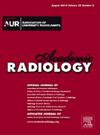Ultrasound-Based Deep Learning Radiomics Nomogram for Tumor and Axillary Lymph Node Status Prediction After Neoadjuvant Chemotherapy
IF 3.8
2区 医学
Q1 RADIOLOGY, NUCLEAR MEDICINE & MEDICAL IMAGING
引用次数: 0
Abstract
Rationale and Objectives
This study aims to explore the feasibility of the deep learning radiomics nomogram (DLRN) for predicting tumor status and axillary lymph node metastasis (ALNM) after neoadjuvant chemotherapy (NAC) in patients with breast cancer. Additionally, we employ a Cox regression model for survival analysis to validate the effectiveness of the fusion algorithm.
Materials and Methods
A total of 243 patients who underwent NAC were retrospectively included between October 2014 and July 2022. The DLRN integrated clinical characteristics as well as radiomics and deep transfer learning features extracted from ultrasound (US) images. The diagnostic performance of DLRN was evaluated by constructing ROC curves, and the clinical usefulness of models was assessed using decision curve analysis (DCA). A survival model was developed to validate the effectiveness of the fusion algorithm.
Results
In the training cohort, the DLRN yielded area under the receiver operating characteristic curve values of 0.984 and 0.985 for the tumor and LNM, while 0.892 and 0.870, respectively, in the test cohort. The consistency indices (C-index) of the nomogram were 0.761 and 0.731, respectively, in the training and test cohorts. The Kaplan-Meier survival curves showed that patients in the high-risk group had significantly poorer overall survival than patients in the low-risk group (P < 0.05).
Conclusion
The US-based DLRN model could hold promise as clinical guidance for predicting the status of tumors and LNM after NAC in patients with breast cancer. This fusion model can also predict the prognosis of patients, which could help clinicians make better clinical decisions.
基于超声深度学习的新辅助化疗后肿瘤和腋窝淋巴结状态预测放射组学提名图
理论依据和目标:本研究旨在探索深度学习放射组学提名图(DLRN)预测乳腺癌患者新辅助化疗(NAC)后肿瘤状态和腋窝淋巴结转移(ALNM)的可行性。此外,我们还采用 Cox 回归模型进行生存分析,以验证融合算法的有效性:回顾性纳入了 2014 年 10 月至 2022 年 7 月间接受 NAC 治疗的 243 例患者。DLRN整合了临床特征以及从超声(US)图像中提取的放射组学和深度迁移学习特征。通过构建ROC曲线评估了DLRN的诊断性能,并使用决策曲线分析(DCA)评估了模型的临床实用性。为了验证融合算法的有效性,还开发了一个生存模型:在训练队列中,DLRN 对肿瘤和 LNM 的接收器操作特征曲线下面积值分别为 0.984 和 0.985,而在测试队列中分别为 0.892 和 0.870。在训练队列和测试队列中,提名图的一致性指数(C-index)分别为 0.761 和 0.731。Kaplan-Meier 生存曲线显示,高风险组患者的总生存期明显低于低风险组患者(P 结论:高风险组患者的总生存期明显低于低风险组患者(P 结论:低风险组患者的总生存期明显低于高风险组患者):基于美国的 DLRN 模型有望成为预测乳腺癌患者 NAC 后肿瘤和 LNM 状态的临床指导。该融合模型还能预测患者的预后,从而帮助临床医生做出更好的临床决策。
本文章由计算机程序翻译,如有差异,请以英文原文为准。
求助全文
约1分钟内获得全文
求助全文
来源期刊

Academic Radiology
医学-核医学
CiteScore
7.60
自引率
10.40%
发文量
432
审稿时长
18 days
期刊介绍:
Academic Radiology publishes original reports of clinical and laboratory investigations in diagnostic imaging, the diagnostic use of radioactive isotopes, computed tomography, positron emission tomography, magnetic resonance imaging, ultrasound, digital subtraction angiography, image-guided interventions and related techniques. It also includes brief technical reports describing original observations, techniques, and instrumental developments; state-of-the-art reports on clinical issues, new technology and other topics of current medical importance; meta-analyses; scientific studies and opinions on radiologic education; and letters to the Editor.
 求助内容:
求助内容: 应助结果提醒方式:
应助结果提醒方式:


